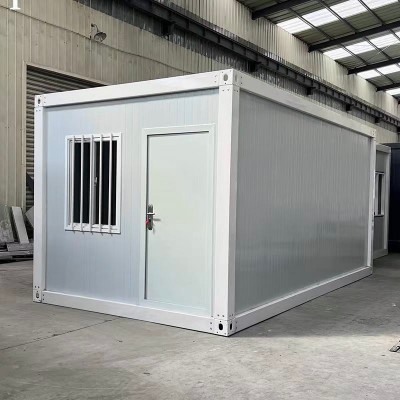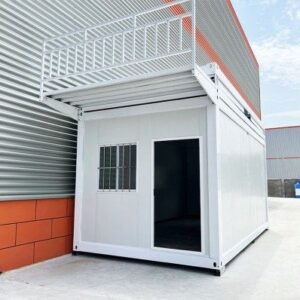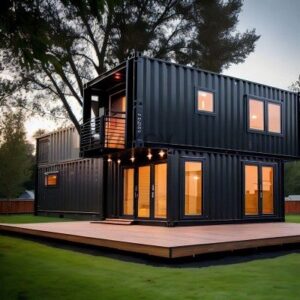Thinking about how to convert shipping container to house? You’re in the right place. Transforming a simple container into a comfortable, stylish home is more achievable than you might think — but it takes smart planning and the right know-how. In this guide, you’ll get a clear, step-by-step look at everything from choosing the perfect container to handling insulation, plumbing, permits, and more. Whether you’re a DIY enthusiast or exploring professional options, this is your go-to resource for turning steel boxes into dream homes. Let’s get started!
Shipping Container Homes Types Sizes and Pros Cons
Shipping container homes have become a popular alternative for affordable and sustainable housing solutions across the United States. Converting shipping containers into homes offers a unique blend of durability, modular design, and eco-friendliness. Before starting a shipping container home conversion, it’s important to understand the types and sizes of containers commonly used, their advantages and disadvantages, and what challenges to realistically expect.
Types and Sizes of Shipping Containers Commonly Used
The most popular containers for home building are:
- 20-foot container: Measures approximately 20 ft long, 8 ft wide, and 8.5 ft tall. Ideal for small studios or tiny homes.
- 40-foot container: Roughly double the length of a 20 ft container with the same width and height. Offers more living space and layout flexibility.
- High cube container: Available in 40 ft or 45 ft lengths with an extra foot in height (9.5 ft tall) providing more headroom.
- Used vs new containers: Used containers cost less but may require more inspection and maintenance for damages or rust, while new containers provide a cleaner, more reliable starting point.
Pros of Using Shipping Containers for Housing
- Durability: Built to withstand harsh marine environments, containers offer strong structural integrity.
- Modularity: Easy to stack and combine multiple units for customized designs.
- Speed: Faster construction compared to traditional builds.
- Cost-effective: Lower material costs can make container homes more affordable.
- Eco-friendly: Reusing containers reduces waste and the carbon footprint from conventional housing materials.
Cons of Shipping Container Homes
- Insulation challenges: Metal containers demand proper insulation to handle hot and cold climates.
- Structural modifications needed: Cutting openings for doors and windows requires reinforcing to maintain strength.
- Limited space and layout constraints: The narrow width (about 8 ft) restricts interior design options unless multiple containers are merged.
- Permitting and zoning can be complex: Not every area readily approves container living structures.
- Potential for corrosion and moisture issues: Requires careful waterproofing and ventilation planning.
Realistic Expectations and Challenges
Building a shipping container home is not a simple DIY project for most. It demands careful planning, professional assessments, and adherence to local building codes. Common challenges people face include managing insulation effectively, ensuring structural integrity when cutting container walls, and dealing with zoning requirements. Also, integrating plumbing and electrical systems inside steel containers can be trickier than in traditional homes.
Understanding these factors early will help you set realistic goals and prevent costly surprises during your shipping container home conversion.
Planning Your how to convert shipping container to house
Defining Your Goals and Budget
Before diving into a shipping container home conversion, clear goals are key. Ask yourself:
- What’s the end use? Full-time living, vacation, rental, or office?
- How much space do you need?
- What’s your budget range? Keep in mind costs for materials, labor, permits, and unexpected expenses.
Setting a realistic budget early helps avoid costly surprises later on. Factor in costs like foundation work, insulation, structural modifications, and finishing. Contingency funds of 10-15% are smart to keep handy.
Choosing the Right Container
New vs. used containers is a big question. Here’s what to consider:
- New containers offer better structural integrity and fewer chemical contaminants but cost more.
- Used containers are cheaper and more readily available but require careful condition assessment.
When assessing used containers, check for:
- Rust, holes, or structural damage
- Previous cargo type (avoid those with chemical or hazardous cargo history)
- Container age and maintenance history
Choosing the right container is the first step. The size matters too—common options are 20-foot and 40-foot containers, with 40-foot containers providing roughly 320 square feet interior space.
Site Selection and Zoning Permits
Location matters just as much as the container itself. Before buying or delivering containers:
- Research local zoning laws—not every area allows container homes, so check with your local planning department.
- Understand building permit requirements and any HOA restrictions.
- Consider site accessibility (can heavy trucks deliver containers?) and the land’s suitability for foundation work.
Failing to get permits or ignoring local codes can delay or halt your project, so stay proactive here.
Designing Your Container Home Layout
Your layout largely depends on whether you plan to use a single container or multiple units:
- Single container homes typically work best for tiny houses or minimalistic designs.
- Multiple containers allow for more complex layouts and increased living space but require more structural and design planning.
Think about how you’ll connect containers—welding, bolting, or stacking—and plan for door/window placements early on. Design with flow and function in mind, balancing open living areas with privacy zones.
Tips for container home design:
- Maximize vertical space since container ceilings are low.
- Plan insulation and ventilation from the start.
- Consider modular designs for easier expansion.
By closely planning your goals, container choice, site, and design, you set your shipping container home conversion up for a smoother build and a livable, comfortable space.
Structural Modifications and Preparation for Shipping Container Home Conversion
Converting a shipping container into a livable home means making key structural modifications while ensuring the container remains strong and secure. Here’s what you need to know about cutting openings, reinforcing structures, foundation choices, and protecting your container.
Cutting and Reinforcing Container Walls for Windows and Doors
- Cutting openings for windows and doors is essential for natural light and access but weakens the container’s structure.
- When you cut into the steel walls, reinforce edges with steel frames or support beams to maintain strength.
- Use professional welding for these reinforcements to prevent structural failures.
- Plan openings carefully—avoid cutting large sections without adequate support, especially on the long walls that bear the load.
Structural Reinforcements and Welding Tips
- Containers are strong because of their corner posts and corrugated steel walls. Alterations can compromise this.
- Add steel braces or columns inside the container if large spaces are opened up or multiple containers are joined.
- Welding must be done by someone experienced with shipping container steel, which is thicker and tougher than typical building steel.
- Double-check load-bearing adjustments if you stack containers or create multi-level designs.
Foundation Choices for Shipping Container Homes
Choosing the right foundation is crucial for stability and longevity.
| Foundation Type | Pros | Cons | Best Use Case |
|---|---|---|---|
| Concrete Slab | Strong, stable, durable | More expensive, longer install | Permanent homes on flat land |
| Pier Foundation | Cost-effective, minimal soil impact | May require extra support | Uneven terrain or flood-prone areas |
| Gravel Pad | Great drainage, easy setup | Less stable for multi-story | Temporary or small container homes |
| Crawl Space | Allows access under home | Can be costly and complex | Homes with plumbing underfloor |
- A solid foundation also prevents moisture issues and helps with insulation.
- Local soil and climate conditions will guide your choice.
Waterproofing and Rust-Proofing Techniques
- Shipping containers are steel and prone to rust and corrosion, especially where metal is cut or welded.
- Start with a thorough inspection; remove any rust or damage on purchased containers before starting.
- Use high-quality rust-proof paint or coatings on both inside and outside.
- Seal all joints and openings with waterproof sealants to prevent water intrusion.
- Consider adding a roofing system or cladding that helps shed water away and protects the metal shell.
By carefully planning structural changes and foundation setup along with rust protection, you ensure your container home is solid, safe, and built to last in the US climate.
Insulation and Ventilation for Shipping Container Homes
When converting shipping containers into homes, insulation and ventilation are crucial to make the space comfortable year-round. Without proper insulation, container homes can turn into ovens in summer or freezers in winter. Ventilation is equally important to maintain good air quality and prevent moisture buildup that leads to mold and rust.
Best Insulation Methods for Shipping Container Homes
Here are the most effective insulation options for container house conversions:
- Spray Foam InsulationThis is a popular choice because it seals gaps tightly, adds structural strength, and has a high R-value, meaning better thermal resistance. It’s great for sealing the steel walls, but it can be pricey compared to other types.
- Rigid Foam PanelsThese panels are durable and easy to install on interior walls. They provide good insulation without eating into your living space too much. Ideal for DIY container home builds.
- Blanket Insulation (Fiberglass or Mineral Wool)Less expensive and widely available, blankets work well if installed with a proper vapor barrier. However, they require framing inside the container walls, which reduces interior space.
Climate Considerations for Insulation
- Hot and Humid AreasUse insulation with vapor barriers to stop moisture from getting trapped. Spray foam works best here to block both heat and humidity.
- Cold ClimatesFocus on higher R-value insulation like rigid foam or thick spray foam to prevent heat loss. Double-layered insulation with an air gap can help as well.
- Mixed ClimatesCombine insulation methods to balance heat retention and moisture control. Ventilation becomes especially important to reduce condensation.
Ventilation Solutions for Shipping Container Houses
- Mechanical Ventilation SystemsInstalling energy recovery ventilators (ERVs) or heat recovery ventilators (HRVs) helps keep fresh air flowing without wasting energy, especially in tightly sealed containers.
- Natural VentilationStrategically placing windows, vents, and doors allows cross-breezes that improve air quality. Consider operable skylights or roof vents if your design allows.
- Dehumidifiers and FansThese are easy additions to control moisture, especially in areas prone to dampness. Portable or built-in options help prevent mold growth.
Key Points
- Proper insulation boosts energy efficiency and comfort.
- The insulation choice depends heavily on your local climate.
- Ventilation prevents moisture buildup, improves air quality, and protects your metal structure.
- Combining both insulation and ventilation methods leads to a healthier, more durable container home.
Planning your shipping container home’s insulation and ventilation right from the start saves money and headaches later, ensuring a cozy and safe living space.

Plumbing and Electrical Systems for Shipping Container Homes
When converting a shipping container to a house, planning your plumbing and electrical systems thoroughly is essential to ensure safety, functionality, and comfort.
Electrical Wiring Installation
- Plan your electrical layout early: Decide where outlets, lighting, and appliances will go before starting any wiring. This helps avoid costly changes later.
- Hire a licensed electrician if you’re not experienced with electrical systems. Container homes require proper grounding and adherence to local electrical codes to prevent hazards.
- Use weather-resistant and insulated wiring designed for metal structures to prevent shorts and corrosion.
- Consider energy-efficient lighting and appliances to reduce power consumption.
- Integrating smart home technology can provide easy control over lighting, temperature, and security systems.
Plumbing Setup Basics
- Plan plumbing routes with easy access in mind, keeping water lines and drains centralized to reduce complexity and cost.
- Container homes need plumbing for:
- Kitchens (sink, dishwasher)
- Bathrooms (toilet, shower, sink)
- Laundry (washer hookups)
- Use Pex piping for its flexibility and resistance to corrosion.
- Ensure your setup complies with local plumbing codes and inspection requirements.
- Proper ventilation for drains and water heater installation is important to avoid issues like pressure buildup or leaks.
Integrating Renewable Energy Options
- Solar panels are a popular choice for container homes, especially for off-grid living or lowering electricity bills. Mount panels on the roof or nearby structures.
- Consider battery storage systems to store solar energy for nighttime or cloudy days.
- Rainwater harvesting systems can supply non-potable water for irrigation or toilets, helping reduce reliance on municipal water.
- Include filtration systems if you plan on using harvested rainwater for drinking or cooking.
- Look into energy-efficient heaters and water systems, such as tankless water heaters or heat pump systems, for sustainability.
Interior and Exterior Finishing for Shipping Container Homes
Finishing your shipping container house is where the space turns from a raw shell into a comfortable living area. Both interior and exterior finishes play a key role in comfort, style, and durability.
Interior Finishing Options
When converting a shipping container into a home, choosing the right interior finishes is essential for comfort and visual appeal. Consider these common options:
- Drywall: Provides a traditional home look and allows for easy painting and customization. It also helps with soundproofing.
- Wood Paneling: Adds warmth and texture, perfect for a cozy, cabin-like feel. Wood can also be more durable against container movement.
- Paint: Using high-quality, moisture-resistant paint directly on insulated steel walls can brighten and protect the space.
Flooring Materials Suited for Containers
Since container floors are usually treated plywood with a metal base, durable and moisture-resistant flooring is critical:
- Vinyl planks or tiles: Waterproof, durable, and easy to maintain, suitable for kitchens and bathrooms.
- Laminate flooring: A budget-friendly lookalike wood finish option, but be wary of moisture.
- Engineered hardwood: Offers natural beauty with more stability than solid wood in fluctuating temperatures.
Exterior Cladding and Aesthetics
The exterior finish affects both protection and curb appeal. Your container home can blend into the environment or make a bold statement:
- Wood siding or composite panels: Natural aesthetics that help with additional insulation.
- Stucco or cement panels: Offer a traditional look and extra weather resistance.
- Metal cladding or corrugated sheets: Keep the industrial vibe, easy to maintain and durable.
- Painting: Protects from rust and lets you customize the color easily.
Adding Decks Patios or Green Roofs
Extending your living space outdoors enhances comfort and adds value:
- Decks and patios: Great for relaxing, entertaining, and connecting with nature. Use treated wood or composite decking for durability.
- Green roofs: Eco-friendly and improve insulation, reduce runoff, and cool your home naturally. Requires proper waterproofing and structural support.
By carefully planning interior finishes and exterior treatments, you can create a shipping container home that’s not only functional but attractive and tailored to your lifestyle.
For more detailed options on container types and customization, check out container options, and for cost considerations visit how much does a shipping container house cost.
Cost Breakdown and Timeline for Shipping Container Home Conversion
When converting a shipping container into a house, understanding the cost and time involved is vital to keep your project on track. Here’s a clear breakdown of typical expenses and how long each phase usually takes, plus tips on budgeting smartly without sacrificing quality.
Typical Cost Estimates by Phase
| Phase | Estimated Cost Range | Notes |
|---|---|---|
| Container Purchase | $2,000 – $6,000 per container | New containers cost more; used containers may have damage or rust to repair. |
| Design and Permits | $1,000 – $5,000 | Depends on local regulations and complexity of permits. |
| Site Prep and Foundation | $3,000 – $10,000 | Costs vary with site condition and foundation type (slab, pier, or crawl space). |
| Structural Modifications | $5,000 – $15,000 | Includes cutting, welding, reinforcing walls, and installing windows/doors. |
| Insulation and Ventilation | $2,000 – $7,000 | Depends on insulation method and ventilation system used. |
| Plumbing and Electrical | $5,000 – $12,000 | Must meet code, includes wiring, fixtures, and possible renewable energy integration. |
| Interior and Exterior Finishing | $7,000 – $20,000 | Flooring, drywall, paint, exterior cladding, and landscaping or decks. |
| Contingency Fund | 10 – 15% of total budget | Always budget extra for unexpected costs. |
Timeline from Start to Finish
- Planning & Permitting: 1 – 3 months
- Container Delivery & Site Preparation: 2 – 4 weeks
- Structural Work: 1 – 2 months
- Insulation & Ventilation Installation: 2 – 4 weeks
- Plumbing & Electrical Installation: 3 – 6 weeks
- Finishing Touches: 1 – 2 months
Overall, expect 6 to 12 months for a full shipping container home conversion, depending on project size, local inspections, and weather conditions.
Budgeting Tips to Reduce Expenses Without Sacrificing Quality
- Buy used containers carefully and get them inspected for structural integrity before purchase to save on initial costs.
- DIY where possible for interior finishing or simple plumbing and electrical work, but always hire licensed pros for safety and permits.
- Plan your design thoughtfully to minimize extensive cutting and welding, which can quickly add up in costs.
- Choose materials smartly — for example, spray foam insulation is pricier but more effective long-term, while rigid panels are cheaper but might require upgrades later.
- Apply for all necessary permits early to avoid fines or forced changes that can increase your timeline and costs.
- Consider phased building if the budget is tight — finish essential parts first, then complete other areas later.
By breaking down your shipping container home conversion costs and timeline clearly, you’ll be better equipped to manage your budget and expectations through every step of the build.
Legal Considerations and Safety for Shipping Container Homes
When converting a shipping container to a house, understanding local building codes and permits is crucial. Regulations vary greatly depending on your location in the United States, so early research is key to avoid costly delays or fines.
Navigating Building Codes and Permits
- Check local zoning laws to see if container homes are allowed in your area. Some neighborhoods or counties restrict non-traditional structures.
- Apply for building permits before starting any structural changes. Submit approved plans that meet local residential construction standards.
- Common permits needed include those for foundation work, electrical wiring, plumbing, and overall occupancy.
- Some regions require your container home to pass inspections similar to conventional homes, focusing on structural integrity, electrical safety, and plumbing systems.
Safety Standards and Inspections
- Shipping container homes must comply with the same safety standards as any traditional home, including fire resistance and proper ventilation.
- Inspections during and after construction ensure your home is safe to inhabit and meets building codes.
- Reinforced structural modifications and correctly installed utilities contribute to passing inspections smoothly.
- Prioritize fireproofing materials and systems, as containers are made of steel, which conducts heat differently than wood or brick.
Insurance Options for Container Homes
- Insurance for container homes can be tricky but not impossible. Some standard homeowners insurance policies may not cover non-traditional homes.
- Look for companies specializing in insuring alternative or modular homes.
- Policy costs will reflect your home’s construction type, materials, and location risks like flooding or fire.
- It’s best to discuss specifics about your shipping container home during the insurance application to ensure proper coverage.
Case Studies and Inspiration for Shipping Container Home Conversion
Looking at real-life shipping container home conversions can spark ideas and help set realistic expectations for your own project. Here are a few examples of successful container homes along with important lessons learned.
Successful Container Home Conversions
- Single Container Urban Studio
- Location: Austin, TX
- Features: A 20-foot used container transformed into a cozy, off-grid studio apartment with solar power and rainwater collection.
- Lessons: Choosing a used container saved money but required thorough rust and structural inspections. Good insulation helped manage Texas heat.
- Multi-Container Family Home
- Location: Portland, OR
- Features: Three containers welded together to provide separate living spaces, including three bedrooms and an open-plan kitchen/living area.
- Lessons: Reinforcing structural joints and carefully planning internal layout maximized space. Obtaining permits required detailed plans and local code compliance.
- Eco-Friendly Vacation Retreat
- Location: Asheville, NC
- Features: A 40-foot container with green roof, extensive exterior cladding, and natural wood interiors blending into the mountain scenery.
- Lessons: Investing in quality waterproofing and insulation paid off for high-humidity climates. Adding decks expanded living space without major construction complexity.
Common Pitfalls to Avoid
- Ignoring Local Building Codes: Many container home projects hit delays or extra costs because they didn’t get permits in advance. Always check zoning laws and building requirements early on.
- Underestimating Structural Work: Cutting out windows or doors without proper reinforcement can lead to costly repairs and unsafe structures.
- Poor Insulation Choices: Skimping on insulation or ventilation leads to uncomfortable living conditions, especially in extreme climates.
- Unrealistic Budgeting: Not accounting for professional labor, foundation work, or finishing can blow your budget. Always have a contingency fund.
- Inadequate Site Preparation: Skipping soil tests or foundation prep can cause stability issues down the road.
Inspiration to Keep You Going
Shipping container homes can suit a variety of lifestyles—from tiny off-grid cabins to full family residences. Whether you want a sleek urban pad or a rustic countryside retreat, learning from others’ successes and challenges will keep your project on track and inspire you to make creative choices that fit your goals.
By understanding what has worked and what hasn’t, you can avoid costly mistakes and build a container home that’s practical, sustainable, and truly your own



